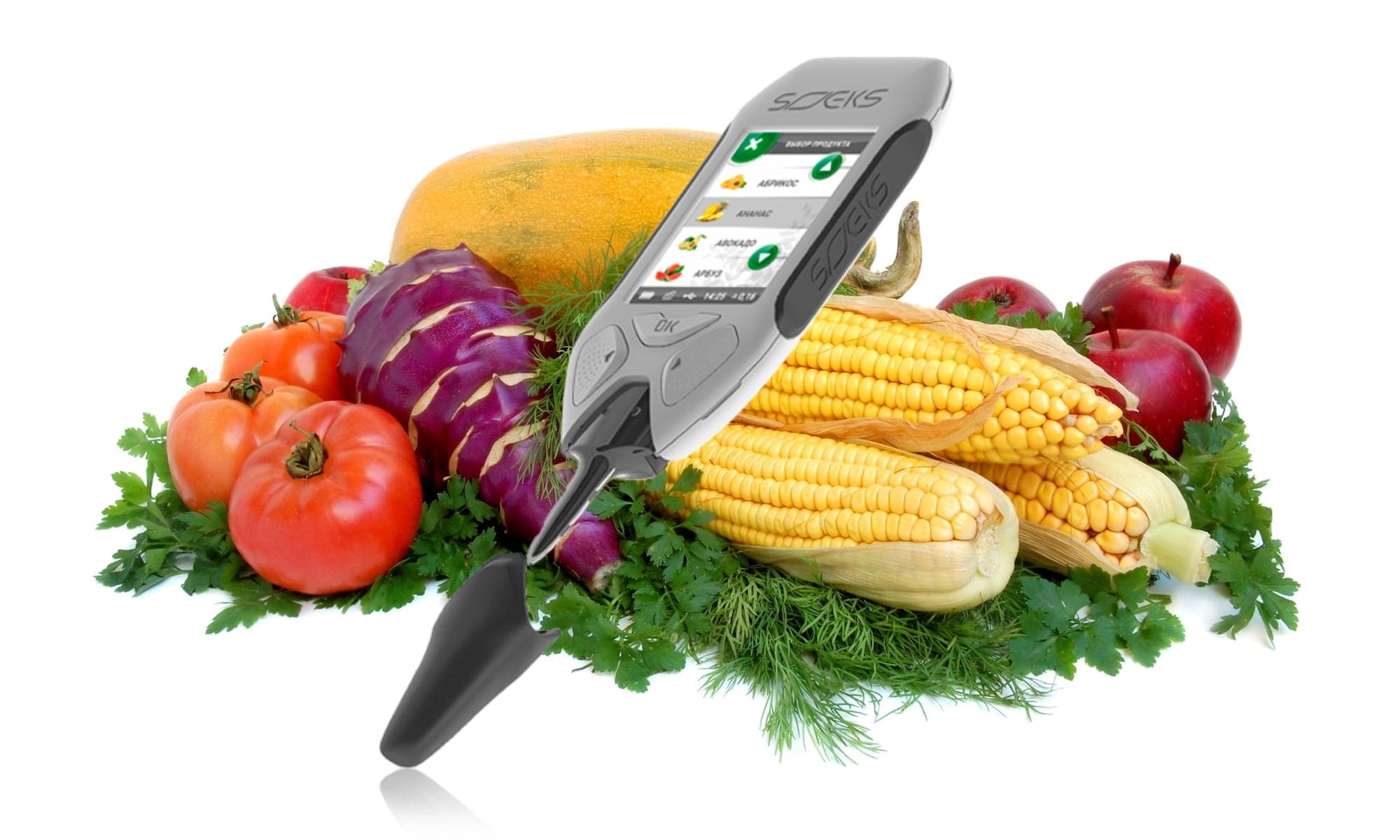Understanding the environmental fate of nitrates and nitrites may help pinpoint potential sources of exposure. This would be important in assessment of patient exposure risk, prevention and mitigation of nitrate / nitrite overexposure and in the prevention of adverse health effects from exposure.
Environmental Nitrogen Cycle
In general, the following describes the activity of nitrates and nitrites in the environment. Microbial action in soil or water decomposes wastes containing organic nitrogen into ammonia, which is then oxidized to nitrite and nitrate.
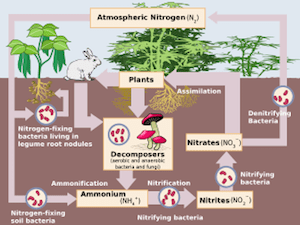
- Because nitrite is easily oxidized to nitrate, nitrate is the compound predominantly found in groundwater and surface waters.
- Contamination with nitrogen-containing fertilizers (e.g. potassium nitrate and ammonium nitrate), or animal or human organic wastes, can raise the concentration of nitrate in water.
- Nitrate-containing compounds in the soil are generally water soluble and readily migrate with groundwater.
Water Contamination
Shallow, rural domestic wells are those most likely to be contaminated with nitrates, especially in areas where nitrogen-based fertilizers are widely used.
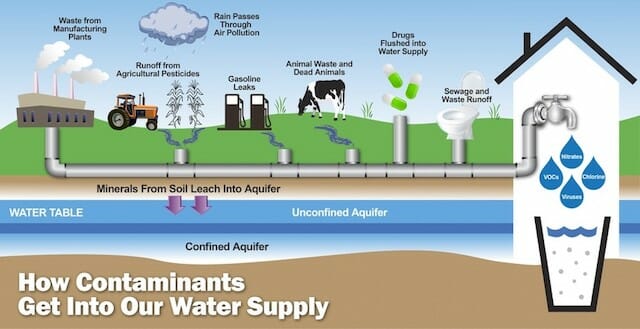
- Approximately 15 percent of Americans rely on their own private drinking water supplies which are not subject to U.S. Environmental Protection Agency (EPA) standards, although some state and local governments do set guidelines to protect users of these wells.
- In agricultural areas, nitrogen-based fertilizers are a major source of contamination for shallow groundwater aquifers that provide drinking water.
- A recent United States Geological Survey study showed that 7 percent of 2,388 domestic wells and about 3 percent of 384 public-supply wells nationwide were contaminated with nitrate levels above the EPA drinking water standard of 10 parts per million (ppm) or 10 mg/L.
- Elevated concentrations were most common in domestic wells that were shallow (less than 100 feet deep) and located in agricultural areas because of relatively large nitrogen sources, including septic systems, fertilizer use, and livestock.
- Although suppliers of public water sources are required to monitor nitrate concentrations regularly, few private rural wells are routinely tested for nitrates.
- During spring melt or drought conditions, both domestic wells and public water systems using surface water can show increased nitrate levels.
- Drinking water contaminated by boiler fluid additives may also contain increased levels of nitrites.
- Mixtures of nitrates / nitrites with other well contaminants such as pesticides and VOCs have been reported.
Food Contamination
Nitrate and nitrite overexposure has been reported via
ingestion of foods containing high levels of nitrates and nitrites. Inorganic nitrates and nitrites present in contaminated soil and water can be taken up by plants, especially green leafy vegetables and beet root.
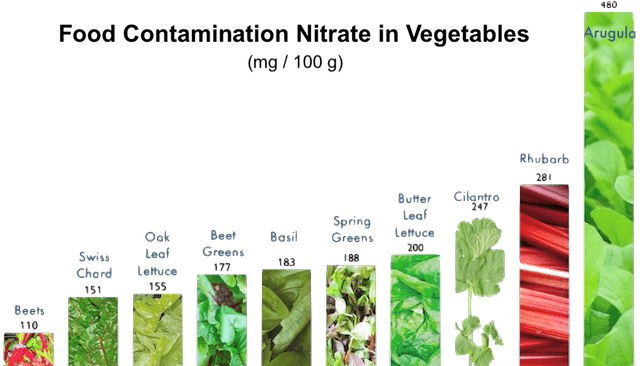
- Contaminated foodstuffs, prepared baby foods, and sausage / meats preserved with nitrates and nitrites have caused overexposure in children.
- Although vegetables are seldom a source of acute toxicity in adults, they account for about 80% of the nitrates in a typical human diet.
- Celery, spinach lettuce, red beetroot and other vegetables have naturally greater nitrate content than other plant foods do.
- The remainder of the nitrate in a typical diet comes from drinking water (about 21%) and from meat and meat products (about 6%) in which sodium nitrate is used as a preservative and color- enhancing agent.
- For infants who are bottle-fed, however, the major source of nitrate exposure is from contaminated drinking water used to dilute formula.
- Bottled water is regulated by the U.S. Food and Drug Administration (FDA) as a food. It is monitored for nitrates, nitrites and total nitrates / nitrites.
Nitrate Content of Selected Vegetables
| Vegetable | Nitrate content, mg / 100g fresh weight |
| Celery, lettuce, red beetroot, spinach | Very High (> 2500) |
| Parsley, leek, endive, Chinese cabbage, fennel | High (100-250) |
| Cabbage, dill, turnip | Medium (50-100) |
| Broccoli, carrot, cauliflower, cucumber, pumpkin | Low (20-50) |
| Artichoke, asparagus, eggplant, garlic, onion, green bean, mushroom, pea, pepper, potato, summer squash, sweet potato, tomato, watermelon | Very Low (<20) |
Other Sources of Exposure
Nitrate or nitrite exposure can occur from certain medications and volatile nitrite inhalants.
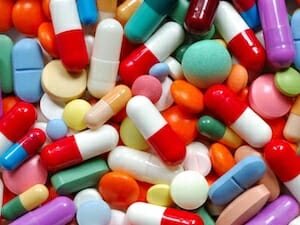
Accidental and inadvertent exposures to nitrites as well as ingestion in suicide attempts have been reported.
Deliberate abuse of volatile nitrites (amyl, butyl, and isobutyl nitrites) frequently occurs. Amyl nitrite (nicknamed by some as “poppers”) is used commercially as a vasodilator and butyl / isobutyl nitrites can be found in products such as room air fresheners.
Fatalities have been reported in adults exposed to nitrates in burn therapy; however infants and children are especially susceptible to adverse health effects from exposure to topical silver nitrate used in burn therapy.
Other medications implicated in methemoglobinemia include:
- Quinone derivatives (antimalarials),
- Nitroglycerine,
- Bismuth subnitrite (antidiarrheal),
- Ammonium nitrate (diuretic),
- Amyl and sodium nitrites (antidotes for cyanide and hydrogen sulfide poisoning),
- Isosorbide dinitrate/tetranitrates (vasodilators used in coronary artery disease therapy),
- Benzocaine (local anesthetic), and
- Dapsone (antibiotic).
Other possible sources of exposure include ammonium nitrate found in cold packs and nitrous gases used in arc welding.
An ethyl nitrite folk remedy called “sweet spirits of nitre” has caused fatalities.
Key Points
- Shallow, rural domestic wells are those most likely to be contaminated with nitrates, especially in areas where nitrogen based fertilizers are in widespread use.
- Other nitrate sources in well water include seepage from septic sewer systems and animal wastes.
- Foodstuffs high in nitrates, home prepared baby foods, and sausage/meats preserved with nitrates and nitrites have caused overexposure in children.
- Nitrate or nitrite exposure can occur from certain medications and volatile nitrite inhalants.


